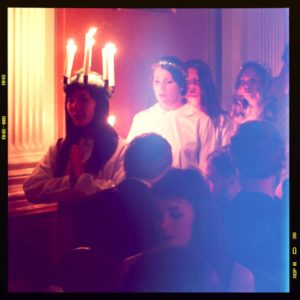 Hej! So, a few weeks back I promised more on Lussebullar (Lucia saffron buns, baked in the shape of an 8… or a curled up cat, depending on your baking skills), so here it is, my Lucia article (because I am sure you are all getting slightly tired of hearing about the snow!). Lucia is a really, really Swedish celebration which happens on the 13th December every year, and is just about impossible to avoid – not that you would want to! Shops begin selling the aforementioned lussebullar from the beginning of December, going into overdrive on the actual day itself; there are regional and nationwide contests to be crowned Lucia of the year in which the public vote; so, what’s it all about?
Hej! So, a few weeks back I promised more on Lussebullar (Lucia saffron buns, baked in the shape of an 8… or a curled up cat, depending on your baking skills), so here it is, my Lucia article (because I am sure you are all getting slightly tired of hearing about the snow!). Lucia is a really, really Swedish celebration which happens on the 13th December every year, and is just about impossible to avoid – not that you would want to! Shops begin selling the aforementioned lussebullar from the beginning of December, going into overdrive on the actual day itself; there are regional and nationwide contests to be crowned Lucia of the year in which the public vote; so, what’s it all about?
Lucia celebrations are said to have their origins in Nordic folklore: the 13th December was believed to be a dangerous night (possibly from being the longest night under the Julian calendar), with rumours that animals would become bewitched and start to talk. Later it was also meant to symbolise the time when you could start getting ready for Christmas – although nowadays people by no means wait until the 13th to begin their preparations! It is tradition for Lucia to wear candles on her head, arising from the story of Saint Lucia bringing light in the darkness of prisons as she brought food to the prison inmates, with her handmaidens in a Luciatåg or Lucia procession (which happen everywhere, from nursery schools to concert halls, all around the country) carrying candles in their hands again to ward away the dark. Lucia herself will also have a red ribbon tied around her waist, to represent the blood she spilt when killed for her good works (ca. 300 AD). The boys get to be stjärngossar, or “star boys”, and instead of candles carry a star-decorated stick in their hands, wear conical hats also decorated with stars, and like Lucia and her maidens, wear long white gowns.
After that the characters become a little more colourful. A Luciatåg will most often also include pepparkaksgubbar (gingerbread people), tomtar (small Santa-like elves), and sometimes a Staffan ställedrang, a version of St Stephen as a horse groom (although this origin of the Staffan ställedrang isn’t widely remembered). During a Lucia celebration, the Luciatåg will sing songs, including the compulsory Luciassången (Lucia song, most commonly “Natten går tunga fjat” or “Heavy footsteps in the night”), Tomtarnas julnatt (“The elves’ Christmas night”, sung often solely by the elves), and my personal favourite Tre pepparkaksgubbar (“Three gingerbread men”). After the Luciatåg has finished their procession, the traditional goodies of pepparkakor (gingerbread), lussebullar and glögg (mulled wine) are often shared, before heading home, feeling full of wintery goodness at having successfully warded off all the evil the dark can bring…or maybe that warm, glowing feeling is just the glögg taking effect…
Whatever it may be, Lucia celebrations are a joy to see, with the glowing of many candles and the mixture of the pure white and the more colourful costumes. And as this will be my last post before Christmas, I would like to wish you all en riktigt God Jul och Gott Nytt År!


God fortsättning!
Just a small, small comment about Staffan. He is “stalledräng” (not “ställedrang”). Stall=stable. Dräng=farmhand (or something like that).
Once again, god fortsättning, (good continuing???) of Christmas and Happy New Year!